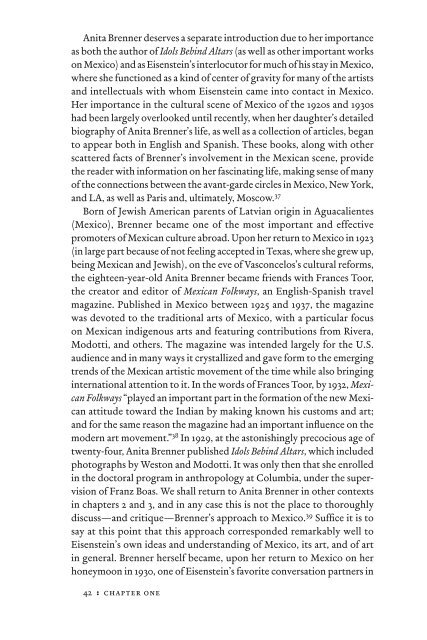In Excess: Sergei Eisentein's Mexico - Cineclub
In Excess: Sergei Eisentein's Mexico - Cineclub
In Excess: Sergei Eisentein's Mexico - Cineclub
You also want an ePaper? Increase the reach of your titles
YUMPU automatically turns print PDFs into web optimized ePapers that Google loves.
Anita Brenner deserves a separate introduction due to her importance<br />
as both the author of Idols Behind Altars (as well as other important works<br />
on <strong>Mexico</strong>) and as Eisenstein’s interlocutor for much of his stay in <strong>Mexico</strong>,<br />
where she functioned as a kind of center of gravity for many of the artists<br />
and intellectuals with whom Eisenstein came into contact in <strong>Mexico</strong>.<br />
Her importance in the cultural scene of <strong>Mexico</strong> of the 1920s and 1930s<br />
had been largely overlooked until recently, when her daughter’s detailed<br />
biography of Anita Brenner’s life, as well as a collection of articles, began<br />
to appear both in English and Spanish. These books, along with other<br />
scattered facts of Brenner’s involvement in the Mexican scene, provide<br />
the reader with information on her fascinating life, making sense of many<br />
of the connections between the avant-garde circles in <strong>Mexico</strong>, New York,<br />
and LA, as well as Paris and, ultimately, Moscow. 37<br />
Born of Jewish American parents of Latvian origin in Aguacalientes<br />
(<strong>Mexico</strong>), Brenner became one of the most important and effective<br />
promoters of Mexican culture abroad. Upon her return to <strong>Mexico</strong> in 1923<br />
(in large part because of not feeling accepted in Texas, where she grew up,<br />
being Mexican and Jewish), on the eve of Vasconcelos’s cultural reforms,<br />
the eighteen-year-old Anita Brenner became friends with Frances Toor,<br />
the creator and editor of Mexican Folkways, an English-Spanish travel<br />
magazine. Published in <strong>Mexico</strong> between 1925 and 1937, the magazine<br />
was devoted to the traditional arts of <strong>Mexico</strong>, with a particular focus<br />
on Mexican indigenous arts and featuring contributions from Rivera,<br />
Modotti, and others. The magazine was intended largely for the U.S.<br />
audience and in many ways it crystallized and gave form to the emerging<br />
trends of the Mexican artistic movement of the time while also bringing<br />
international attention to it. <strong>In</strong> the words of Frances Toor, by 1932, Mexican<br />
Folkways “played an important part in the formation of the new Mexican<br />
attitude toward the <strong>In</strong>dian by making known his customs and art;<br />
and for the same reason the magazine had an important infl uence on the<br />
modern art movement.” 38 <strong>In</strong> 1929, at the astonishingly precocious age of<br />
twenty-four, Anita Brenner published Idols Behind Altars, which included<br />
photographs by Weston and Modotti. It was only then that she enrolled<br />
in the doctoral program in anthropology at Columbia, under the supervision<br />
of Franz Boas. We shall return to Anita Brenner in other contexts<br />
in chapters 2 and 3, and in any case this is not the place to thoroughly<br />
discuss—and critique—Brenner’s approach to <strong>Mexico</strong>. 39 Suffi ce it is to<br />
say at this point that this approach corresponded remarkably well to<br />
Eisenstein’s own ideas and understanding of <strong>Mexico</strong>, its art, and of art<br />
in general. Brenner herself became, upon her return to <strong>Mexico</strong> on her<br />
honeymoon in 1930, one of Eisenstein’s favorite conversation partners in<br />
42 : chapter one


